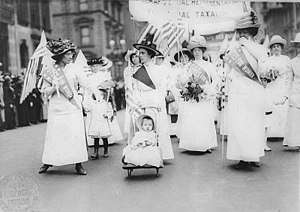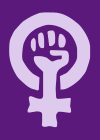White feminism
White feminism is an epithet used to describe feminist theories that focus on the struggles of white women without addressing distinct forms of oppression faced by ethnic minority women and women lacking other privileges.[1]
In first-wave feminism

First-wave feminism began in the early modern period and continued into the early 20th century, and focused primarily on legal issues pertaining to women, especially women's suffrage. This wave officially started with the 1848 Seneca Falls Convention in Seneca Falls, New York, towards the end of the Industrial Revolution. The goal of this wave was to open up opportunities for women, with a focus on suffrage.[2] It was a movement predominantly organized and defined by middle-class, educated white women, and concentrated mostly on issues pertaining to them.[3][4]
Some ethnic minority women were embraced in the movement, such as suffragette Princess Sophia Duleep Singh among the British first-wave feminists. However, there is little evidence that black women participated in the British suffragette effort. In 1893, New Zealand became the first nation to grant women of all races the right to vote; this was met with anger from suffragists including Millicent Fawcett, who expressed displeasure that Māori women in one of the British colonies were able to vote, while British women of society were not.[5] Susan B. Anthony (a staunch abolitionist) and Elizabeth Cady Stanton fought for white women to get the right to vote in the United States of America, prioritising this above black men getting the right to vote.[6] Anthony and Stanton were wary of creating an "aristocracy of sex"; rather, they proposed universal suffrage, such that the black community and women (including black women) get enfranchised at the same time.
In second-wave feminism

Second-wave feminism, particularly at its outset, was similarly shaped by middle-class, educated white women, and again it did not tend to consider issues that were specifically relevant to ethnic minority women.[7]
During the second and third-wave feminist periods, scholars from marginalised communities began to write back against the way in which feminist movements had been essentializing the experiences of women. The notable feminist scholar bell hooks brought this issue to the forefront of feminist thought, regularly writing about the struggles that black women experienced and emphasizing that the feminist movement was exclusionary towards those women by virtue of its inattention to the interactions between race, gender, and class.[8] hooks argued that white women should recognise the fact that they, like ethnic minority men, occupied a position of being both oppressed while also being oppressors.
Today
Today's feminists sometimes emphasize intersectional perspectives in their work.[9] Despite this, some have argued that feminist media continues to overrepresent the struggles of straight, middle class, white women.[10][7] The position held by some modern feminist authors that racism is not an element of society that feminism needs to be concerned with has also been cited as exemplifying white feminism.[11]
It has also been argued that the beliefs of some feminists that hijabs, burqas, and niqabs are oppressive towards Muslim women are representative of white feminism. Notably, many Muslim women have spoken out in defense of their religious dress practices.[12]
White feminism portrays a view of feminism that can be separated from issues of class, race, ability, and other oppressions. An example of white feminism in the present day can be seen in the work of Emily Shire,[13] politics editor at Bustle and an op-ed contributor for The New York Times. Shire argues that feminism excludes some women who do not share political viewpoints when it takes positions on Israel and Palestine, efforts to raise the minimum wage, and efforts to block the construction of oil pipelines.[14] Shire's position contrasts with intersectional feminist activists who view pay equity, social justice, and international human rights as essential and inseparable commitments of feminism, as articulated in the Day Without a Woman platform that "[recognizes] the enormous value that women of all backgrounds add to our socio-economic system – while receiving lower wages and experiencing greater inequities, vulnerability to discrimination, sexual harassment, and job insecurity".[15] While Shire advocates for a feminism that achieves inclusivity by avoiding political positions so as to not alienate women who disagree with those positions,[14] organizers of the Women's March hold the principle that "women have intersecting identities" necessitating a movement that focuses on a "comprehensive agenda".[16]
References
| Wikiquote has quotations related to: White feminism |
- ↑ Frankenberg, Ruth (1993-01-01). "Growing up White: Feminism, Racism and the Social Geography of Childhood". Feminist Review (45): 51–84. doi:10.2307/1395347.
- ↑ "Four Waves of Feminism | Pacific University". www.pacificu.edu. Retrieved 2017-11-20.
- ↑ "Encyclopædia Britannica's Guide to Women's History". kids.britannica.com. Retrieved 2016-12-27.
- ↑ Elkholy, Sharin N. "Feminism and Race in the United States". Internet Encyclopedia of Philosophy. Retrieved 27 December 2016.
- ↑ Sanghani, Radhika (6 October 2015). "The uncomfortable truth about racism and the suffragettes". The Daily Telegraph. Retrieved 27 December 2016.
- ↑ Savali, Kirsten West (23 April 2016). "'When and Where I Enter': The Racist Expectations of Whites-Only Feminism". The Root. Retrieved 27 December 2016.
- 1 2 "A Brief History: The Three Waves of Feminism". Progressive Women's Leadership. 2015-09-22. Retrieved 2017-11-20.
- ↑ hooks, bell (2001). "Black Women: Shaping Feminist Theory". In Bhavnani, Kum-Kum. Feminism and 'Race'. New York: Oxford University Press. pp. 33–39. ISBN 0-19-878236-5.
- ↑ Allen, Amy (Fall 2016). "Feminist Perspectives on Power". Stanford Encyclopedia of Philosophy. The Metaphysics Research Lab, Stanford University. Retrieved February 3, 2017.
- ↑ Nadeau, Mary-Jo (2009). "Troubling Herstory: Unsettling White Multiculturalism in Canadian Feminism". Canadian Woman Studies. 27: 6–13 – via ProQuest.
- ↑ "When White Feminists Respond to Anti-Racism Like Men Respond to Feminism — Everyday Feminism". everydayfeminism.com. Retrieved 2016-12-07.
- ↑ "THIS → The trouble with (white) feminism". this.org. Retrieved 2016-12-08.
- ↑ "Emily Shire". www.bustle.com. Retrieved 2017-03-08.
- 1 2 Shire, Emily (2017-03-07). "Does Feminism Have Room for Zionists?". The New York Times. ISSN 0362-4331. Retrieved 2017-03-08.
- ↑ "A Day Without a Woman". Women's March on Washington. Retrieved 2017-03-08.
- ↑ Women's March (March 8, 2017). "Guiding Vision and Definition of Principles" (PDF). www.womensmarch.com. Retrieved March 8, 2017.
